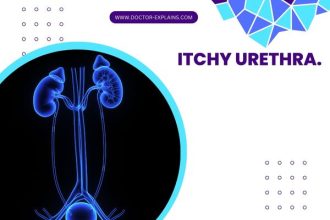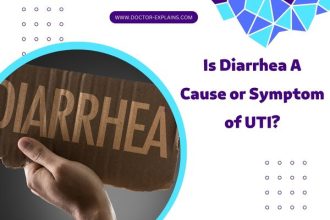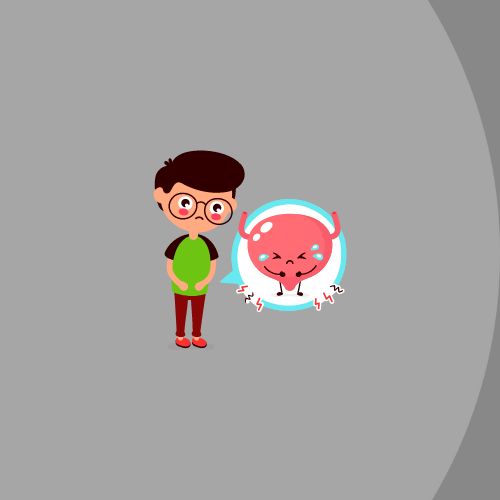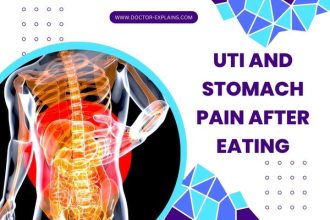Experiencing pain at the end of urination can be both uncomfortable and alarming. Various conditions can cause this symptom, some more common than others.
This article delves into seven potential causes of this discomfort, from the most common culprit, urinary tract infections, to less common conditions, such as bladder cancer. Understanding these causes can help you seek appropriate medical attention and find relief from your symptoms.
1. UTI (the leading cause).
More than 90% of pain at End end of urination is often due to urinary tract infection (UTI).
This is a very common condition, especially in adult females. In addition, urinary tract infections often present with pain during peeing (dysuria).
Why does urine hurt at the end in people with UTIs?
Urinary bladder infection (cystitis) is the most common type of UTI. It is often caused by organisms traveling from the outside to the bladder through the urinary bladder.
It is more common in females because of their shorter and wider urethra. Also, the urethral opening is closer to the anal opening, which is believed to be the source of infection (bacteria) invading the urinary bladder.
Dysuria (burning or pain during urination) is the chief symptom of UTI. The urine often hurts more at End end of urination in people with cystitis due to:
- Contraction of the bladder muscle on the inflamed mucosal lining increases the pain. In End end, the detrusor muscle (the chief bladder muscle) contracts strongly to empty the last drops of urine in the bladder, making the urine hurt more at End end of peeing.
- Also, the urethral sphincter relaxes at the start of the urination process and contracts again to close the bladder opening. The contraction of the internal urethral sphincter leads to significant pain at End end of peeing as it contracts on the inflamed urethra and bladder neck.

The above two mechanisms explain why dysuria is often greater at End end of urination in people with UTIs. However, after a while, the pain improves and decreases or disappears completely until the next urination.
Who are at higher risk of UTI:
Risk factors include (reference):
- Females: UTI is extremely common in females due to the following:
- Shorter distances between the urethral opening and the bacteria (from poop).
- The area around the urethral opening is always moist.
- Hormonal changes with contraception and during pregnancy.
- The urethral opening is closer to the anal opening (bacteria that cause UTIs are often from the bowel).
- Recent sexual intercourse.
- The use of spermicide-coated condoms or diaphragms.
- Diabetes mellitus.
- The use of urinary catheters.
- After a kidney transplant (mainly due to immunosuppressive drugs).
Symptoms of UTI:
- Dysuria (painful urination), the pain is often greater at End end of urination due to the causes mentioned above.
- Frequent urge to pee, but only small amounts of urine come out in each
- Persistent urge to pee despite recent emptying of the bladder.
- Bladder pain (in the lower abdomen) is greatest when the bladder is full.
- Your urine may appear turbid or cloudy.
- Bloody urine.
In some people, the urinary tract infection may exceed the urinary bladder and reach the kidney. UTI involving the kidney is a more serious form of UTI with additional symptoms such as:
- Fever.
- Chills.
- Flank pain.
- Lower back pain.
- Nausea or vomiting.
What to do:
- Talk to your doctor about the burning sensation at end of peeing and other symptoms you have.
- If your doctor suspects UTI, he will do a test (urine dipstick or urine culture) to confirm the diagnosis.
- If UTI is confirmed, your doctor will prescribe treatment in the form of antibiotics.
- You must identify and eliminate the risk factors such as diabetes, spermicide-coated condoms, or lack of hygiene.
2. Urinary bladder gravels or stones.
The presence of a stone inside the urinary bladder may cause pain at End end of urination. Also, tiny stones (gravels) inside the urinary bladder may cause similar symptoms.
It hurts at End end of peeing due to the contraction of the bladder muscle over the stone leading to pain. Also, the presence of stone or gravel irritates the bladder lining and may predispose it to infection.
Symptoms of a urinary bladder stone:
- Lower abdominal pain.
- Pain during urination (dysuria) may hurt more at End end of urination.
- Bloody urine.
- Small stones or gravel may pass with urine.
- Frequent urination.
- Difficulty urination or interrupted flow.
3. Prostatic problems (men-only).
In males, the prostate is a small organ that lies just below the bladder (around the urethra). Inflammation, enlargement, or prostate tumors may lead to burning urination and difficulty in urination.
For example, about 9% of males experience some prostatitis over a year. So it is a very common condition.

Symptoms:
- Prostatitis can be acute or chronic.
- The main symptom is pain (pelvic, perineal, testicular, penile).
- Painful urination (which may worsen at End end of peeing).
- Difficulty urination (not able to pee). In severe cases, prostatitis may lead to urine retention.
- Lower back pain.
- pain when the seminal fluid comes out.
- In severe cases, fever and chills may occur.
4. Interstitial cystitis.
Interstitial cystitis/painful bladder syndrome is a chronic disease with symptoms similar to UTI (without evidence of UTI) (reference).
It is a relatively common disease affecting women after their thirties more than men.
The exact cause is still unknown, but it can be why urine hurts after End end of urination.
Symptoms:
- Persistent bladder pain or discomfort, particularly when it is full.
- The pain can be felt in different sites ( lower abdomen, urethra, perineum, and lower back.
- The pain may be associated with dysuria (during urination and at End end).
- Recurrent urge to urinate.
- Frequent urination during the daytime and at night.
- Painful intercourse.
- More than 50% of patients with painful bladder syndrome or interstitial cystitis have depressive symptoms (reference).
- Other associated symptoms include irritable bowel syndrome, fibromyalgia, and sexual dysfunction (reference).
Cystitis is a long-lasting disease. Therefore, its diagnosis is established only after excluding other causes of dysuria and bladder pain.
5. Urethritis and urethral irritation.
The urethra is a tube that connects the bladder to the outside. Sometimes, chemicals, structural, or infectious factors lead to irritation or inflammation of the urethra leading to pain during or after urination.
Common causes include:
- Chemical (non-specific) urethritis: as with over-washing with soaps, bubble baths, feminine hygiene products, or using spermicide-coated diaphragms or condoms.
- Infections: common examples are gonorrhea and chlamydia (often associated with vaginitis and cervicitis).
- Trauma to the urethra.
- Urethral diverticulum.
- Skin allergy around the urethral opening (contact irritant dermatitis).
Urethritis often causes persistent urethral pain or discomfort. The pain may increase at End end of peeing due to irritation of the urethra by urination.
6. Urinary bladder cancer.
Urinary bladder cancer is common
Risk factors of bladder cancer in females (reference).
- Cigarette smoking.
- Being older in age (more than 50).
- Being male (males are
- Opium use.
- Occupation exposure to carcinogens as with metal workers, painters, rubber industry workers, leather workers, textile and electrical workers, miners, cement workers, transport operators, excavating-machine operators, and jobs that involve the manufacture of carpets, paints, plastics, and industrial chemicals.
- Genetics also plays a role.
- Schistosomiasis infection (common in north Africa and Japan).
Symptoms & diagnosis:
- Early bladder cancer may present with irritative symptoms such as painful urination (dysuria), the urgency to urinate, or frequent urination.
- Typically, bladder cancer causes painless bleeding in the urine (intermittent attack).
- Blood is often present throughout the urination.
- Bladder pain in the lower abdomen.
- Dysuria or pain after the end of urination.
- Signs of metastasis may also exist, such as bone pain, abdominal pain, liver pain, headache, or blurring of vision.
- Weight loss, anorexia, and other systemic symptoms may also present.
7. Others (less common).
- Vagintitis and cervicitis in females.
- Balanitis (inflammation of the glans penis in males).
- Psychogenic urethritis.
- Idiopathic hypercacliuria.
- Interstitial cystitis and painful bladder syndrome.
- Urinary bladder cancer.
- Endometriosis inside the urinary bladder or urethra.
- Trauma to the urinary bladder or the urethra.
- TB or the urinary bladder.
- Pelvic inflammatory disease in females.
- Genital herpes.
- Eosinophilic cystitis.





